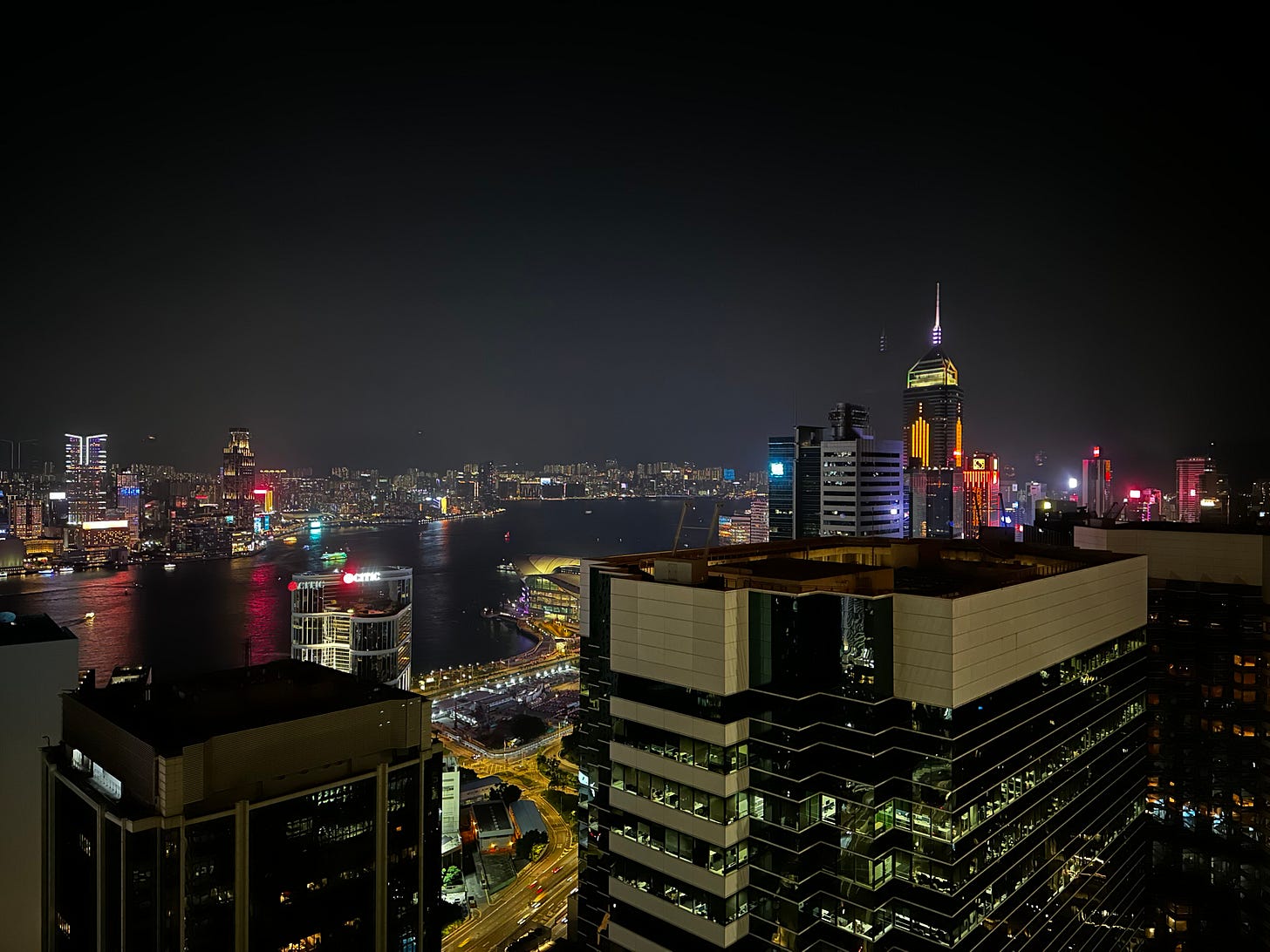And then touched down on the tarmac. Chek Lap Kok confines the concrete complex to its fish-shaped shores. Levelled by ambition, this island in the New Territories hosts a new airport, rushed unsuccessfully to completion in time for the handover. 26 years later—much more cargo, many more cranes, myriad planes.
Our express train shot across the bay. 24 minutes later, disturbed only by the hoicking and spitting of our fellow passengers, we slid silently into the main station. Hong Kong island was quiet. Our hospitality informed us that Golden Week had just ended. Of the 700 million domestic tourists that swarmed over China, an uncountable amount had descended on this city. Underneath our skyscraper-hotel lay a maze of malls. These spotless marble corridors extended for miles underground—manicured, polished, burnished and buffed. Spelunking for Saint Laurent was easy there. The Hermès-to-human ratio was absurd.
On the surface, atop the commercial chthon, night had come. A cyberpunk acropolis celebrated the 75th anniversary of the People’s Republic of China. In commemoration, the International Commerce Centre cast Chinese characters over 484 glass metres. Across the rest of the city, the giants of finance and industry loomed. Billboards, lit up in the red and white of HSBC or the green and blue of Standard Chartered, reflected an irregular rainbow on the water.
—
The island was falling asleep. Before we did so ourselves, we had to see sleepless Kowloon. The Star Ferry carried us across Victoria Harbour. The night wind tasted humid-sweet. We docked at Tsim Sha Tsui and disembarked. Heading up Salisbury Road, we soon turned onto Nathan. Our object was to escape the seafront—to see the real Hong Kong.
Progressing north, the streets of Kowloon became alleys. The modern pinnacles merged into overbearing apartment-blocks. Tenements hung over shuttered shops and restaurants. Air conditioning units clung to every wall. Their exertion dripped onto the street below. The humidity became suffocating; its smell cycled between urine, drunken chicken, abalone or century eggs.
—
The morning. Kowloon again. Tsuen Wan line to Jordan Station. Breakfast at the Australia Dairy Company! The cha chaan teng delivers food instantaneously. Perfect butter toast and scrambled egg swallowed down with green tea precedes a chicken soup swimming with macaroni and ham. We’ve been forced to daap toi, that is, to sit with other diners. Two lovely old ladies from Vancouver. Sisters, born in Hong Kong, but left for Canada decades ago. Now frequently return. They teach us the ropes of the cha chaan teng. There’s no menu—just choose your eggs, scrambled or fried. The milk tea must come last.
—
After breakfast, we begin our nostalgia tour—visiting my father’s childhood sites. We pass the famous Yue Hwa Chinese Products Emporium and stride north-east up Waterloo Road, cutting through Ho Man Tin. At the junction of Argyle and Waterloo history is more than visible. The modernist clock tower of the China Light and Power Company (now branded ‘CLP Group’) could easily be found in a Greater London suburb. On the opposite side, the Kowloon T.B. Clinic is a marked reminder of the disease that troubles Hong Kong to this day. The two roads bound Kadoorie Hill, named after the CLP’s owners, a merchant family of Baghdadi Jews, contemporaries of the Sassoons. The other streets here are Scottish. Dunbar complements Argyle. Tweed becomes Perth. Wylie links Princess Margaret and Waterloo.
—
Up in the clouds, one sees Kai Tak, jutting out into Kowloon Bay. Hong Kong’s story of development and redevelopment continues there. The new stadium has replaced the old terminal. Planes no longer scrape the tops of buildings. Kowloon Walled City has disappeared. Out at sea, a junk glides towards the Kimmerian lands, and its peopled cities.
—





